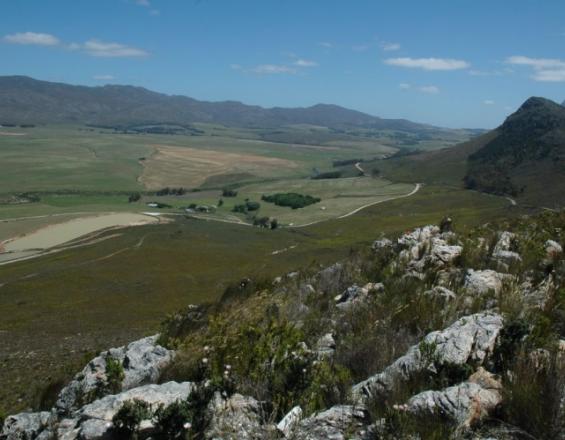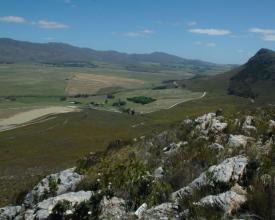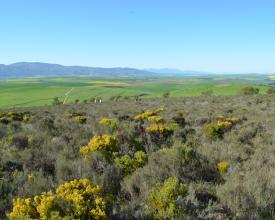
Public-private partnership to develop a climate-proof PA network
Full Solution

The existing pass which runs through Critically Endangered Overberg Sandstone Fynbos
Chris Burgers
Fifteen percent of the Western Cape is formally protected. Unfortunately, this network is unrepresentative of the biodiversity contained within the province and does not adequately buffer the province against the impacts of climate change. In an endeavor to supplement the existing network, priority areas, which have been identified through systematic biodiversity plans, are being safeguarded through elaborate public private partnership agreements and mainstreaming avenues.
Last update: 29 Mar 2019
3374 Views
Context
Challenges addressed
an unrepresentative and fragmented PA network and ineffective spatial planning processes
• An unrepresentative PA network: Many ecosystems have little or no representation in the PA network.
• A fragmented PA network that does not buffer against the anticipated impacts of climate change, i.e. increased temperatures, sea-level rise, frequent floods and droughts, etc.
• Environmental authorization and spatial planning processes that make little contribution towards protecting biodiversity.
Location
Western Cape Province, South Africa
East and South Africa
Process
Summary of the process
Systematic biodiversity plans identify priority areas which need to be safeguarded. Safeguarding includes a variety of mechanisms ranging from formal protection of land all the way through to the mainstreaming of biodiversity into land-use plans and decisions.
Over the last decade, the primary mechanism for expanding the protected area network has been stewardship. Stewardship has supplemented the existing biased network and has proven to be most effective at protecting small fragmented patches of highly threatened and under-protected vegetation types or creating valuable landscape linkages to help buffer the province against climate change.
Key mainstreaming approaches have been ensuring proper representation of priority biodiversity in land-use planning and decision-making. Land-use planning tools which have been concentrated on include municipal Spatial development Plans (requirements of every municipality in the province), Environmental Management Frameworks and Strategic Environmental Assessments, and Agricultural Area-wide plans. The primary decision-making process which has been focused on is the Environmental Impact Assessment process.
Building Blocks
Systematic Biodiversity Planning
Growing a sustainable economy and establishing a solid social foundation are primary objectives for South Africa. It is thus paramount that land is wisely and efficiently allocated to competing land-uses and that only priority biodiversity areas are set aside for conservation.
Systematic biodiversity planning is the manner in which these priority biodiversity areas are identified. The technique identifies the least amount of land possible, which has to be safeguarded, in order to meet a set of pre-defined biodiversity targets. Where possible, it aims to achieve this through minimizing conflict with competing land-uses.
The biodiversity targets include both pattern (e.g. ecosystem types and point locations of rare or endangered species) and process (e.g. coastal processes or edaphic interfaces) targets. The resultant map of priority biodiversity areas represents a crucial climate change adaptation strategy for the province as it a) favours the protection of cooler south-facing slopes to warmer north-facing slopes; b) buffers aquatic and coastal ecosystems; and c) allows for the migration of species to cooler areas through landscape linkages.
Enabling factors
• A reliable and concise spatially mapped scientific inventory, e.g. land cover, ecosystem types, rare and endangered species location data, protected areas, etc.
• An experienced conservation planner who understands both the ecology of the region and the science of systematic biodiversity planning.
• Funding: The provinces’ pioneering systematic biodiversity plans were produced on funding secured from the GEF. An extensive investment was made into producing these first products, rolling them out to all users and ensuring in-house capacity to update going forward
Lesson learned
• Local biodiversity knowledge needs to feed into formal scientific conservation planning. Private land owners often know more about the biodiversity on their land than the scientific and research institutes do. Reference groups should be established to supplement the scientific knowledge which informs the products.
• When considering which conflicts should be strategically avoided during the planning, try to be unbiased and fair across the entire planning domain. Try to consider avoiding only those conflicts which are provincial objectives. The methodology must be transparent and defensible.
• The applicability of the systematic biodiversity plan depends entirely on the land cover map. Invest resources into ensuring that the land cover map has a high accuracy and is as fine-scaled as possible.
Promoting application of biodiversity planning products
A mainstreaming programme was established to ensure that all a) knew about the products (i.e. the systematic biodiversity plan and guideline); b) had access to the products; c) understood the products; and d) applied the products appropriately in spatial planning, land-use decision-making and PA expansion.
a) a) Advertising: Reference groups and steering committees were constituted to advise on the design and assist with the dissemination of the products.
b) b) Access: A large initial batch of hard copy products was distributed free of charge. Thereafter electronic copies were provided. Copies were also downloadable from an internet-based platform.
c) Understanding: CapeNature appointed a dedicated biodiversity mainstreamer to assist users in the application of the products in land use planning and decision-making. She also conducted intensive training in the first 3 years with key partners, e.g. municipalities, private consultants, EIA officials, etc.
d) Application: A Biodiversity Planning and Implementation Forum was constituted to provide a link between conservation planners and implementers and guide the application of the products.
Enabling factors
Full-time Biodiversity Mainstreamer is required in order to ensure there is continuous presence and involvement from the conservation agency in all land-use planning and decision-making initiatives.
Funds for printing posters, handbooks and DVDs and supporting the dissemination of the products to all users. This was an expensive process. The second round for the new products due in 2016 is however expected to be far less expensive as the baseline training and level of understanding has already been established.
Lesson learned
- Continuous and strategic engagement: Relationships between the producers and users of the products must be set up early. There must be a platform whereby biodiversity planners and implementers can engage. For this initiative it was the Biodiversity Planning and Implementation Forum which convened biannually. Be strategic in the level of involvement, e.g. utilize existing fora as much as possible rather than establishing new workshops, fora or groups.
- Appropriately scaled and accurate products: Products need to be appropriately scaled for the pre-defined use. For example, if they will be informing site-specific land-use decision, we advise a scale of approximately 1:10 000. Courser products are better suited as informants for spatial planning.
Biodiversity stewardship contracts with private land-owners
Biodiversity Stewardship is the practice of safeguarding biodiversity outside of the existing state-owned PA network. It places the responsibility to conserve into the hands of private landowners through a variety of contractual agreements.
CapeNature adopted Biodiversity Stewardship in 2003 as a core strategy as most of conservation-worthy biodiversity is located on private land. Stewardship is also widely regarded as one of the most cost-effective mechanisms for protecting biodiversity.
The programme has resulted in the signing of over 90 contracts between private land owners or communities and CapeNature. 43 of these (amounting to 49 000 ha) have led to formal protection while the remainder represent less formal conservation agreements which nonetheless result in improved ecological management.
The major limitation of the programme is that of capacity within CapeNature. Signing new contracts and servicing existing sites require human and financial resources. For this reason, only top priority sites can join the programme. This is an unfortunate situation as demand from land owners to protect is exceeding the capacity of CapeNature to assist.
Enabling factors
• A culture of respect for the natural environment which has resulted in a high demand from private land owners for conserving land.
• An organisation which is skilled in negotiating and facilitating the formal declaration of private land as Protected Areas as well as a well-experienced and dedicated programme manager.
• A provincial-wide review committee comprised of all key partners involved in stewardship within the province to objectively review all new applications.
Lesson learned
• The demand for Biodiversity Stewardship (i.e. land owners wanting to protect their land) can be higher than the capacity of the conservation agency to deliver. Be careful not to over-sell the programme unless there are resources available within the agency to supply to all.
• Set up a rigorous review process whereby only land of real biodiversity value should be formally protected. Less important land should be freed up for sustainable development.
• Unblock potential of land use decisions to contribute towards PA expansion – i.e. biodiversity offsets.
• Caution not to over commit yourself as the agreements are mostly in perpetuity or else very long term. The same staff who are responsible for signing up in the first few years will need to pick up on auditing and servicing at a later stage. If we cannot deliver on our promises, the programme’s reputation is at stake.
Impacts
• Meaningful contribution of private land owners towards biodiversity conservation: CapeNature’s now well established Biodiversity Stewardship Programme is essentially a public private partnership which allows for private land owners to formally protect priority biodiversity. The land owner is then entitled to tax rebates while the expanded provincial PA network becomes more representative and resilient.
• Informed spatial planning: Based on two comparative studies undertaken in 2008 and 2014, there is clear evidence that municipal Spatial Development Frameworks (SDF) are taking priority biodiversity better into consideration.
• Improved land-use decision-making: Although difficult to quantify, anecdotal evidence indicates that priority biodiversity is being better considered in the environmental authorization processes. Residual impacts on priority biodiversity are also acting as triggers for biodiversity offsets (i.e. reactive stewardship)
Beneficiaries
all the people of the Western Cape Province
Story
SHAW’S PASS REACTIVE STEWARDSHIP SITE
In the Hemel-and-Aarde Valley of the WC, lies Shaw’s Pass. It is located in an area of very high biodiversity value, contains globally unique vegetation and is a core area of floral diversity with exceptionally high numbers of endemic plant species (there are more than 35 plant species of conservation concern in the area).
The area also represents a keystone in one of the Table Mountain Fund climate change corridors. These are the province’s most important intact landscapes to invest in, in order to ensure climate resilience.
In 2008, an EIA process was followed for the resurfacing and realignment of the road. This realignment, which was required for safety reasons, would unfortunately impact on at least 1ha of unique and irreplaceable vegetation, including populations of CR plants. CapeNature objected to these impacts as they would be irreversible and of very high negative significance.
Biodiversity offsets are conservation actions intended to compensate for the residual, unavoidable harm to biodiversity caused by development, so as to aspire to no net loss in biodiversity. Since there were no feasible alternatives to realigning the road and the upgrade was seen as an economic priority, it was decided that an offset could be an appropriate compromise. After lengthy negotiations with the applicant (the Department of Transport and Public Works), it was agreed to offset the impacts of the road. This was the first time that a government department agreed to offset their impacts and thus set a very important precedent.
The offset entailed the following:
• The setting aside and formal protection of 30 ha of remaining habitat as a reactive stewardship agreement where the private land owner remains the owner of this Protected Area; and
• The provision of a lump sum of money for the in perpetuity management of the land to CapeNature- the assigned management authority.
This serves as an example of how the financial burden of managing priority lands can be transferred from CapeNature to the developer. This method of reactive stewardship highlights the potential for the environmental authorization processes to meaningfully contribute towards meeting the Western Cape Protected Area targets and thereby buffering the province against the anticipated impacts of climate change.

